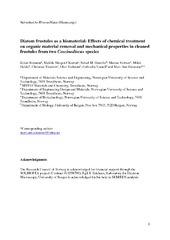| dc.contributor.author | Romann, Julien Clement | |
| dc.contributor.author | Chauton, Mathilde Skogen | |
| dc.contributor.author | Hanetho, Sidsel Meli | |
| dc.contributor.author | Vebner, Marius | |
| dc.contributor.author | Heldal, Mikal | |
| dc.contributor.author | Thaulow, Christian | |
| dc.contributor.author | Vadstein, Olav | |
| dc.contributor.author | Tranell, Gabriella | |
| dc.contributor.author | Einarsrud, Mari-Ann | |
| dc.date.accessioned | 2017-04-28T11:55:09Z | |
| dc.date.available | 2017-04-28T11:55:09Z | |
| dc.date.issued | 2016-08 | |
| dc.Published | Romann J, Chauton MS, Hanetho SM, Vebner M, Heldal M, Thaulow C, Vadstein O, Tranell G, Einarsrud M. Diatom frustules as a biomaterial: effects of chemical treatment on organic material removal and mechanical properties in cleaned frustules from two Coscinodiscus species. Journal of porous materials. 2016;23(4):905-910 | eng |
| dc.identifier.issn | 1380-2224 | en_US |
| dc.identifier.uri | https://hdl.handle.net/1956/15756 | |
| dc.description.abstract | The three-dimensional structure of silica diatom frustules offers a great potential as nanoporous material for several nanotechnological applications, but the starting point for these applications is the ability to obtain clean frustules with sufficient mechanical strength and intact structure. Here, frustules from the diatoms Coscinodiscus centralis Ehrenberg and Coscinodiscus wailesii Gran et Angst are characterized with respect to their structural integrity, content of residual organic biomaterial and their mechanical properties after two cleaning methods using either hydrogen peroxide as oxidizing agent or a combination of a surfactant (sodium dodecyl sulphate) and a complexing agent. Fluorescence microscopy and energy dispersive spectroscopy (SEM/EDS) analysis revealed clear differences regarding the amount of organic residual within the frustules depending on the cleaning process, with little organic material left after the oxidizing method. This method, however, induced a partial cracking of the frustules suggesting an embrittlement due to the cleaning. Nanoindentation confirmed this and showed that the oxidizing method resulted in more brittle frustules compared to the surfactant/complexing method. More efficient cleaning of organic biomaterial may result in more fragile frustules, and the choice of cleaning method must be based on the planned application. | en_US |
| dc.language.iso | eng | eng |
| dc.publisher | Springer | en_US |
| dc.subject | Porous biomaterial | eng |
| dc.subject | Nanomaterial | eng |
| dc.subject | Silica frustules | eng |
| dc.subject | Cleaning protocols | eng |
| dc.subject | Oxidation | eng |
| dc.subject | Surfactant | eng |
| dc.title | Diatom frustules as a biomaterial: effects of chemical treatment on organic material removal and mechanical properties in cleaned frustules from two Coscinodiscus species | en_US |
| dc.type | Peer reviewed | |
| dc.type | Journal article | |
| dc.date.updated | 2017-01-18T21:27:35Z | |
| dc.description.version | acceptedVersion | en_US |
| dc.rights.holder | Copyright 2016 Springer Science+Business Media New York | en_US |
| dc.identifier.doi | https://doi.org/10.1007/s10934-016-0147-6 | |
| dc.identifier.cristin | 1351079 | |
| dc.source.journal | Journal of porous materials | |
